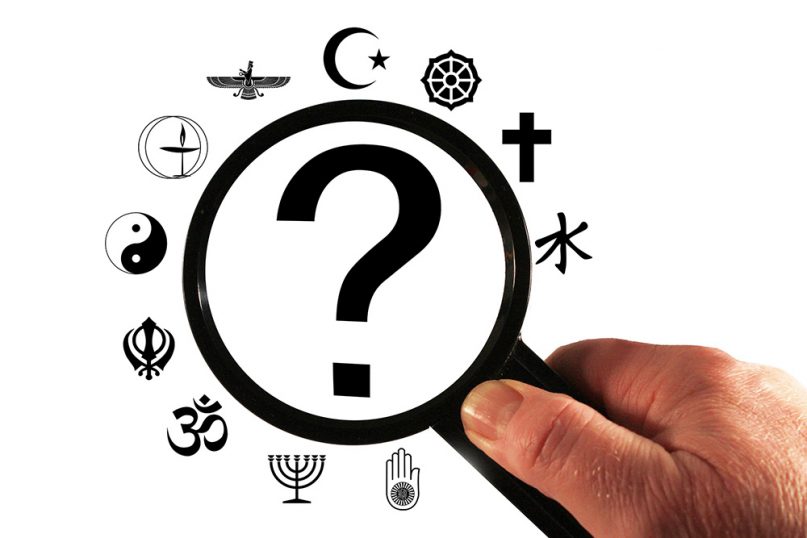(RNS) — On the first Sunday of Advent, I went to a holiday market in Greenpoint, one of Brooklyn’s trendiest neighborhoods, that catered to a clientele mostly in their 20s and 30s. Several dozen stalls were devoted to a wide range of “oddities”: a cornucopia of antique jewelry and risqué fetish-wear; Victorian hair jewelry; animal skulls; even a white taxidermied fox.
But nearly every stall had one – if not several – wares on offer that nodded to the occult. Some were subtle references – pentagrams or alchemically inspired graphite drawings — while others were obvious, like the T-shirt with the slogan “Dykes for Satan.” For customers looking for an easy one-pot spell, there were “Make Your Own Magic” candles for mixing symbolically significant herbs and oils into a candle base.
Not all of the market’s attendees – indeed not all “Make Your Own Magic’s” buyers – might identify themselves as practitioners of magic, or members of some neopagan faith, such as Wicca. Some may have been politically motivated; in the age of Trump, occult imagery, like the aesthetic of “witch feminism,” has become increasingly associated with those who #Resist. Some may have just plain liked the stalls’ vaguely punk ethos of transgression.
But the Oddities Market, as it is called, reflects a point about today’s wider religious marketplace, particularly among young city dwellers: The demarcation between what is and is not religious is becoming increasingly blurred.
A “Dykes For Satan” shirt or a “Make Your Own Magic” candle and the values, ideas and affiliations it expresses aren’t explicitly religious— not in the way that, say, a rosary is. But for an increasing number of Americans, religious identity doesn’t look the way it used to.
About 35 percent of millennials in the United States poll as religiously unaffiliated, as opposed to 24 percent of the American population overall. Whiter, richer, more liberal and more educated than the average population, these “nones” outnumber every other single religious voting bloc in the United States. By contrast, white evangelicals — the most reliable right-leaning voting bloc — comprise less than 15 percent of the voting population.
Yet just because the nones don’t profess a faith doesn’t mean that they’re not interested in spirituality or participating in symbolically resonant rituals.
Seventy-two percent of nones profess belief in some sort of higher power – even if that higher power isn’t necessarily a traditional, major faith deity. A more recent Pew poll found that 62 percent believe in one or more “New Age” principles, including the efficacy of psychics or astrology.

Defining religion has always been a difficult undertaking. Image courtesy of Pixabay/Creative Commons
The millennial nones, too, have pioneered other forms of spirituality. Harvard Divinity School researchers Casper ter Kuile and Angie Thomas have identified “cult” fitness programs like CrossFit and SoulCycle as serving as a form of church for regular participants. Likewise, intense internet fandom communities, say a group of scholars from the University of Leicester in the U.K., foster community through valued texts — from Harry Potter to Buffy the Vampire Slayer — and shared meaning, like any religious group.
As ter Kuile and Thomas have written, this doesn’t necessarily mean people are simply replacing religion with secular equivalents. Rather, they argue that through a kind of religious “unbundling” elements of existing spiritual and religious traditions are increasingly divorced from their original contexts.
More and more practitioners are “mixing and matching,” finding community in CrossFit while developing a spiritual practice in home yoga or meditation. A Jewish person may engage in divination through Tarot cards. Religious life isn’t ending; it’s becoming increasingly diffuse.
Perhaps that’s only natural. After all, even when we talk about a single religion, we’re talking about not one concept but many — identity, shared goals and values that hold us in community, rituals to affirm faith and an overarching narrative of meaning.
Even theorists of religion have a hard time agreeing what single element, if any, makes a religion a religion. French sociologist Émile Durkheim insisted on a “single moral community,” in which people affirmed their own identities in concord with one another. American anthropologist Clifford Geertz saw religion as a “system of symbols” that evoked powerful “moods” in its adherents.
The truth is that religion contains multitudes. As religious identity becomes ever more “unbundled” — and the religiously unaffiliated continue to grow in number — we’ll need to develop a vocabulary for talking about the wealth of practices, beliefs, communities and rituals that shape future faith identities, few of which may be easily reducible to a single label.
In other words, most of America’s young religiously unaffiliated are not so much religious nones as they are religious “manys.” They are like shoppers at a holiday market, finding meanings in an object here (T-shirts to candles), a practice there and picking and choosing among elements of religious life that resonate with them. These elements may not look like traditional organized religion — and they may be less cohesive overall — but, nevertheless, they function in much the same way.
From rationalist solstices to SoulCycle classes, from atheist meditation apps to wellness spa getaways, the “manys” explore the different ways that the religiously unaffiliated are approaching, and redefining, the religious.





